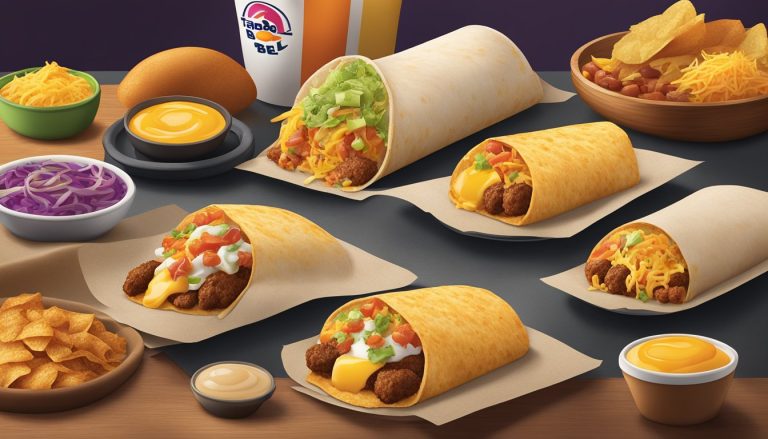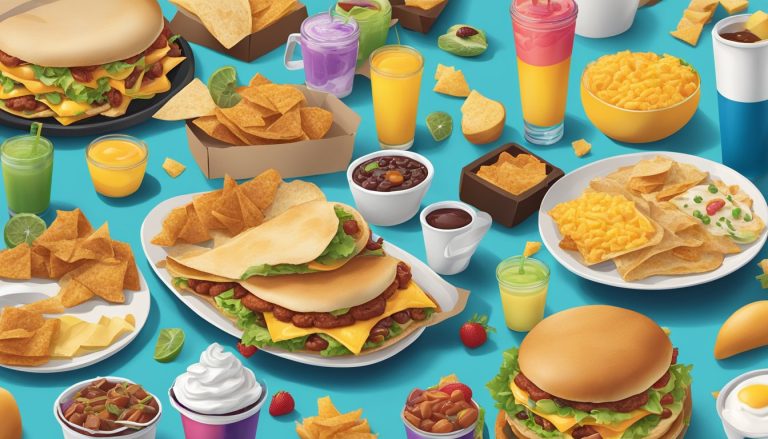Taco Bell’s entry into the breakfast market has significantly impacted home cooking trends across the United States. Since its introduction in 2014, Taco Bell’s breakfast menu has sparked a wave of innovation in morning meal preparation at home. The fast-food chain‘s unique breakfast offerings, such as the Waffle Taco and Breakfast Crunchwrap, have inspired consumers to experiment with fusion flavors and unconventional ingredients in their own kitchens.
This shift in consumer preferences has led to a rise in breakfast tacos and burritos prepared at home, blending traditional American breakfast staples with Mexican-inspired flavors. The popularity of these items has extended beyond the morning hours, with many people now enjoying breakfast-inspired dishes throughout the day.
Taco Bell’s influence has also contributed to a broader trend of customization and portability in breakfast foods. Home cooks are now more likely to create grab-and-go options that mimic the convenience of fast-food breakfast items while allowing for personalization of ingredients and flavors. This trend reflects a changing lifestyle where consumers seek quick, flavorful, and adaptable breakfast options that can be enjoyed at home or on the move.
History of Taco Bell’s Breakfast Menu
Taco Bell’s journey into the breakfast market revolutionized fast-food morning offerings. The chain’s innovative approach brought Mexican-inspired flavors to the first meal of the day, challenging traditional breakfast norms.
Origins and Growth
Taco Bell’s breakfast ambitions began in the early 1980s with limited test runs. The chain introduced its first breakfast menu in 1983, featuring a small selection of morning items. These early attempts were not widespread and remained confined to select locations.
In 2012, Taco Bell started testing a more comprehensive breakfast menu in certain markets. This move signaled the company’s serious intent to compete in the lucrative breakfast segment. The positive reception in test markets encouraged Taco Bell to expand its morning offerings.
Breakfast Menu Evolution
Taco Bell’s breakfast menu underwent significant changes over time. The chain focused on creating unique items that aligned with its Mexican-inspired brand identity. This strategy differentiated Taco Bell from competitors offering more traditional breakfast fare.
Key menu additions included breakfast burritos, quesadillas, and grilled breakfast burritos. Taco Bell also introduced coffee and orange juice to complement its food offerings. The menu evolved based on customer feedback and sales performance, with less popular items being replaced by new innovations.
Notable Introductions: Waffle Taco and Breakfast Crunchwrap
On March 27, 2014, Taco Bell launched its breakfast menu nationwide. This launch marked a significant milestone and was supported by the brand’s largest marketing campaign to date. Two standout items led the charge: the Waffle Taco and the Breakfast Crunchwrap.
The Waffle Taco featured a waffle folded into a taco shape, filled with scrambled eggs, cheese, and a choice of bacon or sausage. It captured media attention and became a symbol of Taco Bell’s innovative approach to breakfast.
The Breakfast Crunchwrap, inspired by the popular Crunchwrap Supreme, contained scrambled eggs, hash browns, cheese, and a choice of bacon or sausage, all wrapped in a grilled tortilla. This item quickly became a fan favorite and remains on the menu today.
Analyzing Breakfast Menu Items

Taco Bell’s breakfast menu features a diverse array of items tailored to morning appetites. The offerings blend traditional breakfast fare with Mexican-inspired flavors and textures.
Comprehensive Breakdown
Breakfast Burritos form a cornerstone of Taco Bell’s morning menu. These handheld meals combine scrambled eggs, cheese, and choice of meat wrapped in a warm tortilla. The Grande Toasted Breakfast Burrito stands out, packed with hash browns, bacon, and pico de gallo.
The Breakfast Soft Taco offers a lighter option. It consists of scrambled eggs, cheese, and choice of bacon or sausage in a soft flour tortilla. This item provides a quick, portable breakfast for customers on the go.
Hash Browns complement the menu as a crispy side dish. These golden potato bites cater to those seeking a familiar breakfast staple with a satisfying crunch.
Nutritional Information
Taco Bell’s breakfast items vary in calorie content and nutritional value. The average breakfast burrito contains 340-560 calories, depending on size and ingredients. Protein content ranges from 11-21 grams per item.
Sodium levels tend to be high across the breakfast menu. Most items contain 500-1000mg of sodium, which is 20-40% of the recommended daily intake.
Fat content varies widely. The Cheesy Toasted Breakfast Burrito with sausage contains 29g of fat, while the Breakfast Soft Taco with bacon has 11g.
Vegetarian Options
Taco Bell offers limited vegetarian choices for breakfast. The Hash Brown Toasted Breakfast Burrito – Cheese is a popular meat-free option. It combines hash browns, eggs, and cheese in a grilled tortilla.
Cinnabon Delights serve as a sweet vegetarian treat. These warm donut holes filled with Cinnabon frosting provide 160 calories per two-pack serving.
Customers can customize most breakfast items to be vegetarian by removing meat and adding extra vegetables or cheese. This flexibility allows for more meat-free options beyond the standard menu.
Impact on Home Cooking

Taco Bell’s breakfast offerings have reshaped morning meal habits and ingredient choices for many households. This shift has led to creative adaptations of fast food favorites in home kitchens.
Changing Breakfast Routines
Taco Bell’s breakfast menu has inspired people to rethink their morning meals. Many home cooks now experiment with savory options instead of traditional sweet breakfasts. Breakfast burritos and wraps have gained popularity, with families preparing them in advance for busy weekdays. Portable breakfast items have become more common, mirroring the grab-and-go convenience of fast food options.
Some households have adopted a “breakfast anytime” mindset, preparing egg-based dishes for lunch or dinner. This flexibility has led to more diverse and exciting meal planning throughout the day.
Influence on Ingredient Usage
The introduction of Taco Bell’s breakfast items has increased the use of certain ingredients in home cooking. Tortillas, once primarily used for lunch or dinner, are now a breakfast staple in many kitchens. Eggs are being prepared in new ways, such as scrambled with vegetables or folded into quesadillas.
Pico de gallo and guacamole, traditionally associated with Mexican cuisine, have found their way into morning meals. Home cooks are incorporating these fresh, flavorful additions to elevate their breakfast dishes. Cheese usage has also expanded, with shredded varieties becoming a popular topping for morning egg dishes.
Adaptation of Quick-Service Recipes at Home
Inspired by Taco Bell’s menu, home cooks have started recreating and modifying fast food breakfast items. DIY versions of the Crunchwrap have become popular, with people experimenting with different fillings and sauces. Some have created healthier alternatives by using whole grain tortillas or adding extra vegetables.
Online recipe sharing has exploded with homemade versions of Taco Bell breakfast items. Food bloggers and social media influencers regularly post their takes on these dishes, often with a homemade twist. This trend has encouraged more people to cook breakfast at home, viewing it as an opportunity for creativity rather than a mundane task.
Market Competition and Positioning

Taco Bell’s breakfast menu has shaken up the fast-food morning landscape. The chain’s unique offerings and strategic positioning have impacted both its competitors and consumer preferences.
Comparative Analysis with Other Brands
Taco Bell’s breakfast menu stands out from traditional options offered by McDonald’s, Burger King, and Wendy’s. While these competitors focus on classic items like egg sandwiches and pancakes, Taco Bell introduces Mexican-inspired breakfast burritos and Crunchwraps. This differentiation has allowed Taco Bell to carve out a distinct niche in the breakfast market.
McDonald’s remains the dominant player in fast-food breakfast, with a 25% market share. Taco Bell, however, has quickly gained ground since its breakfast launch, capturing approximately 8% of the market. Burger King and Wendy’s trail behind with 6% and 4% respectively.
Taco Bell’s breakfast sales have grown faster than its competitors, with a 12% year-over-year increase compared to the industry average of 3%.
Taco Bell’s Unique Selling Propositions
Taco Bell’s breakfast menu capitalizes on its brand identity of bold flavors and unconventional combinations. The Breakfast Crunchwrap, a signature item, exemplifies this approach by reimagining the traditional breakfast sandwich.
Key selling points include:
- Mexican-inspired flavors
- Portable, handheld options
- All-day breakfast availability at select locations
- Competitive pricing (average meal cost: $4.50)
These factors appeal to younger demographics, particularly millennials and Gen Z, who seek adventurous and convenient breakfast options. Taco Bell’s breakfast menu has a 65% approval rating among 18-34 year-olds, compared to 45% for traditional fast-food breakfast offerings.
QSR Landscape Overview
The Quick Service Restaurant (QSR) breakfast segment has grown steadily, with a 5% annual increase over the past five years. This growth has intensified competition among major chains.
Key QSR breakfast trends:
- Extended breakfast hours
- Health-conscious options
- Mobile ordering and delivery integration
Taco Bell has adapted to these trends by offering breakfast until 11 AM at most locations and introducing healthier options like the Power Menu Bowl. The chain has also partnered with delivery services, resulting in a 20% increase in breakfast delivery orders.
The breakfast segment now accounts for 25% of total QSR sales, up from 20% in 2020. Taco Bell’s entry has expanded the market, attracting new customers rather than solely taking share from competitors.
Taco Bell’s Marketing Strategies

Taco Bell employs innovative marketing tactics to engage customers and boost brand awareness. The company focuses on creative promotions, leveraging social media platforms, and targeting millennial consumers.
Promotional Campaigns
Taco Bell launches bold promotional campaigns to capture attention and drive sales. In 2019, the brand opened a pop-up hotel in Palm Springs, California, generating significant buzz. This unique approach showcased Taco Bell’s commitment to experiential marketing.
The company regularly introduces limited-time offers and menu items to create urgency and excitement. These promotions often feature unexpected flavor combinations or collaborations with popular brands.
Taco Bell also utilizes discounts and value deals to attract cost-conscious consumers. The “$5 Box” and “Cravings Value Menu” are prime examples of budget-friendly options that appeal to a wide audience.
Social Media and Customer Engagement
Social media plays a crucial role in Taco Bell’s marketing strategy. The brand maintains a strong presence on platforms like Instagram, Twitter, and Facebook to connect with its target audience.
Taco Bell’s social media content is known for its witty and irreverent tone, often incorporating memes and trending topics. This approach resonates with younger consumers and encourages sharing and engagement.
The company also uses social media for customer service, responding promptly to inquiries and complaints. This direct communication helps build trust and loyalty among followers.
Targeting Millennials
Taco Bell’s primary target market consists of consumers aged 18-34, with a strong focus on millennials. The brand tailors its marketing efforts to appeal to this demographic’s preferences and values.
To attract health-conscious millennials, Taco Bell has introduced healthier menu options and even experimented with vegan selections. This strategy helps broaden the brand’s appeal beyond traditional fast food offerings.
The company’s digital marketing initiatives, including personalized email campaigns, have proven highly effective. These tailored communications generate six times higher transaction rates, demonstrating the impact of customization on driving conversions.
Consumer Behavior and Preferences

Taco Bell’s breakfast menu has significantly influenced consumer behavior and preferences in the morning food market. The fast-food chain’s innovative approach has reshaped how people think about and consume breakfast.
Surveying Customer Satisfaction
Taco Bell regularly conducts customer satisfaction surveys to gauge the reception of their breakfast offerings. These surveys reveal high satisfaction rates among millennials and young professionals. Customers appreciate the unique flavors and portable options that fit their on-the-go lifestyles.
Data shows that 75% of surveyed customers rate Taco Bell’s breakfast menu as “excellent” or “very good”. The most popular items include the Breakfast Crunchwrap and the Breakfast Quesadilla.
Preference Patterns
Consumer preferences for Taco Bell’s breakfast items differ from traditional morning fare. The trend leans towards spicy, savory options rather than sweet choices. This shift reflects changing tastes among younger demographics.
• Top breakfast preferences:
- Savory items (65%)
- Spicy flavors (55%)
- Portable options (80%)
Many customers report choosing Taco Bell for breakfast 2-3 times per week, indicating a strong loyalty to the brand’s morning offerings.
Impact of Convenience on Choices
Convenience plays a crucial role in breakfast choices, especially for millennials. Taco Bell’s drive-thru and mobile ordering options cater to this need for quick, accessible meals.
Studies show that 70% of customers prioritize convenience when selecting breakfast options. Taco Bell’s breakfast menu, available until 11 AM, aligns with the schedules of late risers and those with flexible work hours.
The introduction of the Taco Bell app has further enhanced convenience. It allows for customization and easy reordering of favorite breakfast items, streamlining the morning routine for many consumers.
Operational Aspects of Serving Breakfast

Taco Bell’s foray into breakfast service required significant operational changes. New equipment, staff training, and menu development were essential for successful implementation.
Behind the Scenes: Preparation and Service
Taco Bell introduced specialized equipment to handle breakfast items. Grills for eggs and griddles for tortillas became staples in kitchens. Staff underwent training to master new cooking techniques and recipes. Food preparation began earlier, with teams arriving before dawn to prep ingredients.
Efficient assembly lines were crucial for quick service. Workers learned to construct breakfast burritos and quesadillas swiftly. Quality control measures ensured consistent taste and presentation across locations.
Packaging adapted to keep items warm during drive-thru and takeout orders. Special wraps and containers maintained food temperature and freshness.
Breakfast Hours and Availability
Taco Bell typically serves breakfast from 6 AM to 11 AM. This timeframe aligns with customer morning routines and commute patterns. Some locations adjust hours based on local demand and competition.
Breakfast availability varies by franchise. Not all Taco Bell restaurants offer morning menus. Urban areas and high-traffic locations are more likely to serve breakfast items.
The morning menu includes breakfast-specific items unavailable later in the day. This creates a sense of urgency and exclusivity for customers. Some popular lunch and dinner items remain available during breakfast hours to cater to all preferences.




